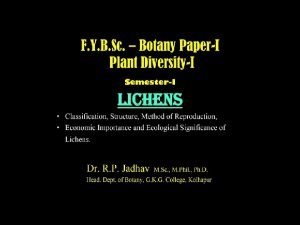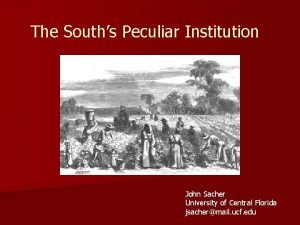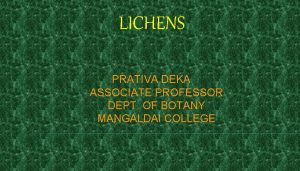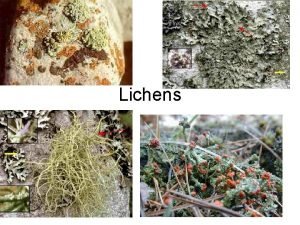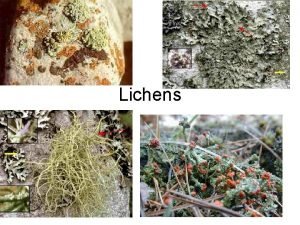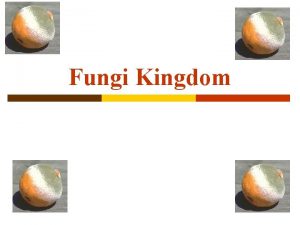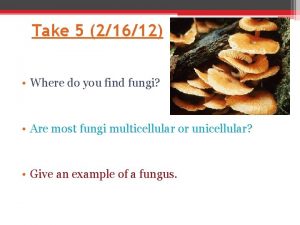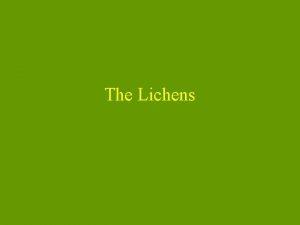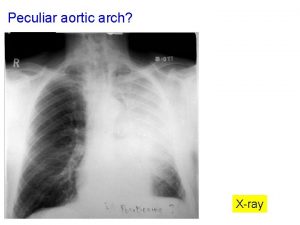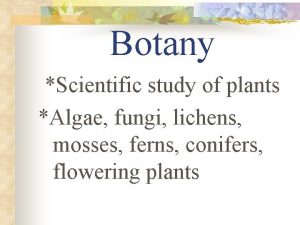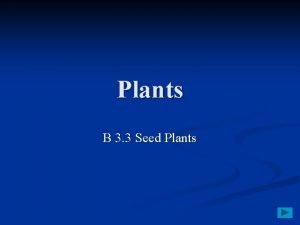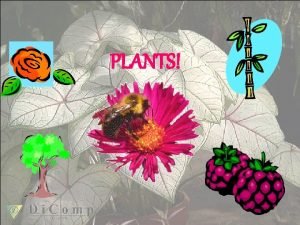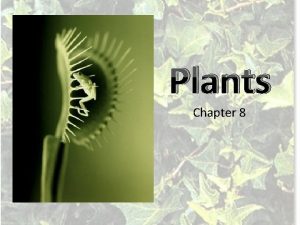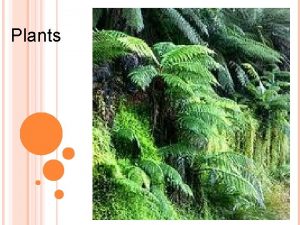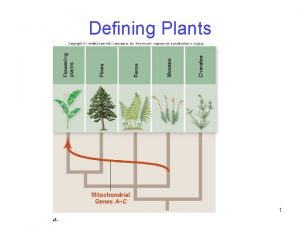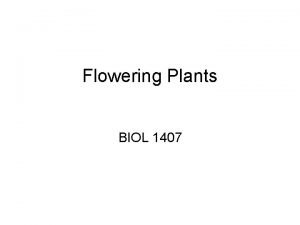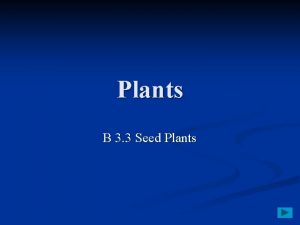Lichens Lichens are very peculiar group of plants







































- Slides: 39


Lichens • Lichens are very peculiar group of plants as they are composites. The thallus of Lichen is formed of two quite different organisms known as a fungus( a mycobiont) and an alga(a phycobiont). The mycobiont belongs to Ascomycetae or Basidiomycetae, while the phycobiont generally a unicellular alga.

Lichens are symbiotic associations between photosynthetic micro-organisms held in a mesh of fungi. Cladonia fimbriata Different species of lichens growing on a boulder. The fungus gives the lichen its shape. The alga provides the fungus with food. In some lichens the ‘alga’ is a Cyanobacteria and fixes nitrogen. Lichens are colonizers of bare rock but some species are epiphytes found in tree canopies.

Sym biosis together Symbionts: Host: life the organisms involved the larger organism, if there is one Mutualism: both symbionts benefit Commensalism: one symbiont receives benefit while neither harming nor helping the other in any significant way Parasitim: one symbiont, called a parasite, benefits at the expense of the other, usually a host

There are some 16, 000 species of lichen In contrast to the many thousands of lichen fungi, there are only about 100 photosynthetic partners. The algal components can live in isolation with the fungal component – so the symbiotic relationship is not obligate for them. However, no zoospores (the algal resting stage) or gametes are produced while the alga is in the symbiotic relationship though they can produce them when cultured outside of it. In contrast the symbiotic relationship is obligate for the fungal component. The mycelium of a few species may grow under laboratory conditions, on agar, but no lichen specific thallus is produced and no fruiting body develops. The oldest certain fossil lichen is Early. Devonian (about 400 million years old) from the Rhynie Chert.

Lichens are unique as a symbiotic relationship because they look and behave quite differently from their component organisms. Lichens are regarded as organisms in their own right and are given generic and species names. The fungus is termed the mycobiont The green alga or a cyanobacterium is termed the photobiont. The "body" of a lichen is termed the thallus, and its general shape is used to group lichens into four broad categories. Foliose Fruticose Squamulose Crustose Classification by form

Xanthoria parietina The foliose lichen Xanthoria parietina, which grows on surfaces, including concrete, and rocks subjected to sea spray. Much of the surface is covered with bright orange fungal fruiting bodies about 3 -5 mm diameter (arrowheads). The orange colour is due to production of the pigment parietin at the lichen surface. Cross section of one of a lobe viewed by phase-contrast microscopy. The photosynthetic zone (p) is a distinct band of green algal cells. Above this band is the cortex (c) of densely packed fungal cells. The lower part of the thallus consists of a medulla (m) with conspicuous air pockets (a),

Lichen Classification : • Lichens are classified on the basis of their fungal components. They are: • A. Ascolichens- Fungal partner from Ascomycetae. • i) Gymnocarpae- Ascocarp is an apothecium; • ii) Pyrenocarpae- Ascocarp is a perithecium; • B. Basidiolichens- Fungal partner belongs to Basidiomycetae. • Depending on the habitat the lichens are classified as: • i) Saxicolous- Growing on stones and rocks; • ii) Corticolous- Growing on barks of trees; • iii) Terricolous- Growing on soil (terrestrial).

GENERAL CHARACTERS: • A lichen thallus is irregular in shape and greyish in colour. Some may be yellow, orange, brown, or red in colour. The thalli show a great diversity in forms and accordingly maybe indentified as • 1) Crustose(Crustaceous), • 2) Foliose • 3) Fruticose

Crustose lichens: • Crustose lichens: The thallus is insignificant in size and belongs to saxicolous type. It is just a thin layer or a crust closely attached to the substratum. The thallus is divided into hexagonal areas called Areolae

Foliose lichens: • Foliose lichens: The thallus is foliose(leaf-like) in appearance. It is flat and lobed with distinct upper and lower surfaces. The thallus is attached by means of rhizoid-like outgrowths called rhizinae. A rhizinae may consists of a simple, signle branched hypha or a number of closely adhering hyphae. The free end of rhizinae becomes broad to form a disc and functions for absorbption and fixation.

Fruticose lichens: • Fruticose lichens: The thallus is branched, conspicuos and very complex. Branches are usually cylindrical or flattened, but in some species like Usnea they hang and are tassellike. The thallus is attached only at the base by a flattened disc and the upper and lower surfaces are not differentiated. Disc-like ascocarps called apothecium are present.

Fruticose Crustose Foliose

Mycorrhizae means “fungus-root”; mutualistic relationship between plant and fungi The plant photosynthesizes while the fungus more efficiently takes up nutrients and water from the rhizosphere than the roots would alone. Plant benefits include: • Improved nutrient/water uptake • Improved root growth • Improved plant growth and yield • Improved disease resistance • Reduced transplant shock • Reduced drought stress

Soredia are the asexual reproductive part of lichens, containing both symbionts. Rhizines may be present to anchor the lichen. Notice the distinctive algal layer and the fungal layer present in the above illustration.

Cross-section through a lichen Fruiting body of the fungus Fungal hyphae: a filament, composed of single cells joined together end to end

Thallus Structure :

Lichens • Usually consist of three or four layers: – Upper Cortex - Protective layer – Algal Layer - Contain algal cells. – Medulla - Hyphae – Lower Cortex - Covered with Rhizines.

Foliose lichens have a flat, leaflike structure Parmelia physodes, growing on the twigs of a shrub.

Fructicose and Squamulose Fruticose lichens have an erect or pendulous, bushy structure Squamulose lichens have a thallus consisting of minute, scale-like squamules Lecanora muralis with ascocarps pink-brown

Lichens are mutualistic symbiotic organisms.

Crustose lichens produce a flat crust on or beneath rock or tree surfaces











Thallus – Microscopic

Thalle – microscopic :

Apothecium :

Copyright © Mc. Graw-Hill Companies Permission Required for Reproduction or Display

LICHENS Crusrose Foliose Fruticose

Lichens

Thank You
 Insidan region jh
Insidan region jh Lichen cross section
Lichen cross section Peculiar institution apush
Peculiar institution apush Hd 101065
Hd 101065 Define peculiar institution
Define peculiar institution Fat positive comparative superlative
Fat positive comparative superlative The crucible unit test
The crucible unit test Very bad to very good scale
Very bad to very good scale Used to express very large or very small numbers
Used to express very large or very small numbers There is very few soup in the bowl
There is very few soup in the bowl Is a very shallow skillet with very short sloping sides
Is a very shallow skillet with very short sloping sides Quantifiers of food
Quantifiers of food Nonvascular plants
Nonvascular plants Vascular vs nonvascular plants
Vascular vs nonvascular plants Classification of non flowering plants
Classification of non flowering plants C3 plants vs c4 plants
C3 plants vs c4 plants General characteristics of lichen
General characteristics of lichen Lichen association
Lichen association Lichen are the association of
Lichen are the association of Lichen as food
Lichen as food Symbiotic organism
Symbiotic organism Zygomycota produce _____, which germinate into new hyphae.
Zygomycota produce _____, which germinate into new hyphae. Chapter 13 social psychology
Chapter 13 social psychology Within group variance vs between group
Within group variance vs between group Anova within group and between group
Anova within group and between group Types of social group
Types of social group Group 1 vs group 2 specialties
Group 1 vs group 2 specialties Thermal decomposition of group 1 nitrates
Thermal decomposition of group 1 nitrates Amino group and carboxyl group
Amino group and carboxyl group Amino group and carboxyl group
Amino group and carboxyl group In group out group
In group out group Group yourself or group yourselves
Group yourself or group yourselves William graham sumner in group out group
William graham sumner in group out group Joining together group theory and group skills
Joining together group theory and group skills Yours is a very bad hotel
Yours is a very bad hotel Very high speed integrated circuit
Very high speed integrated circuit Very long instruction word
Very long instruction word Mildly flavored vegetables cooking methods
Mildly flavored vegetables cooking methods Excellent very good good fair poor scale
Excellent very good good fair poor scale Medium long shot
Medium long shot

